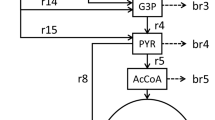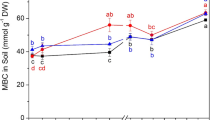Abstract
The effect of soil aeration status on carbon partitioning of a labelled organic substrate (14C-[U]-glucose) into CO2, microbial biomass, and extra-cellular metabolites is described. The soil was incubated in a continuous flow incubation apparatus under four different aeration conditions: (1) permanently aerobic, (2) permanently anaerobic, (3) shifted from anaerobic to aerobic, and (4) shifted from aerobic to anaerobic. The soil was pre-incubated for 10 days either under aerobic or under anaerobic conditions. Afterwards, glucose was added (315 μg C g−1) and the soils were incubated for 72 h according to four treatments: aerobic or anaerobic conditions maintained, aerobic conditions shifted to anaerobic conditions and anaerobic conditions shifted to aerobic conditions. Carbon partitioning was measured 0, 8, 16, 24, 48 and 72 h after the glucose addition. In permanently aerobic conditions, the largest part of the consumed glucose was built into microbial biomass (72%), much less was mineralised to CO2 (27%), and only a negligible portion was transformed to soluble extra-cellular metabolites. Microbial metabolism was strongly inhibited when aeration conditions were changed from aerobic to anaerobic, with only about 35% of the added glucose consumed during the incubation. The consumed glucose was transformed proportionally to microbial biomass and CO2. In permanently anaerobic conditions, 42% of the consumed glucose was transformed into microbial biomass, 30% to CO2, and 28% to extra-cellular metabolites. After a shift of anaerobic to aerobic conditions, microbial metabolism was not suppressed and the consumed glucose was transformed mainly to microbial biomass (75%) and CO2 (23%). Concomitant mineralisation of soil organic carbon was always lower in anaerobic than in aerobic conditions.



Similar content being viewed by others
References
Bremer E, van Kessel C (1990) Extractability of microbial 14C and 15N following addition of variable rates of labelled glucose and (NH4)2SO4 to soil. Soil Biol Biochem 22:707–713
Bremer E, Kuikman P (1994) Microbial utilisation of 14C[U] glucose in soil is affected by the amount and timing of glucose additions. Soil Biol Biochem 26:511–517
Coody PN, Sommers LE, Nelson DW (1986) Kinetics of glucose uptake by soil microorganisms. Soil Biol Biochem 18:283–289
Dictor MC, Tessier L, Soulas G (1998) Reassessment of the KEC coefficient of the fumigation-extraction method in a soil profile. Soil Biol Biochem 30:119–127
Fenchel T, Finlay BJ (1995) Ecology and evolution in anaerobic worlds. Oxford University Press, New York
Gaunt JL, Neue HU, Cassman KG, Olk DC, Arah JRM, Witt C, Ottow JCG, Grant IF (1995) Microbial biomass and organic matter turnover in wetland rice soils. Biol Fertil Soils 19:333–342
Harrison DEF, Loveless JE (1971) Transient responses of facultatively anaerobic bacteria growing in chemostat culture to a change from anaerobic to aerobic conditions. J Gen Microb 68:45–52
Küsel K, Drake HL (1999) Microbial turnover of low-molecular-weight organic-acids during leaf-litter decomposition. Soil Biol Biochem 31:107–118
Larsson C, Vonstockar U, Marison I, Gustafsson L (1993) Growth and metabolism of Saccharomyces cerevisiae in chemostat cultures under carbon-limiting, nitrogen-limiting, or carbon-limiting and nitrogen-limiting conditions. J Bacteriol 175:4809–4816
Linton JD (1991) Metabolite production and growth efficiency. Antonie van Leeuwenh Int J Gen Mol Microbiol 60:293–311
Liu Y (1996) Bioenergetic interpretation on the S0/X0 ratio in substrate-sufficient batch culture. Water Res 30:2766–2770
Liu Y (1998) Energy uncoupling in microbial growth under substrate-sufficient conditions. Appl Microbiol Biotechnol 49:500–505
de Mattos MJ, Neijssel OM (1997) Bioenergetic consequences of microbial adaptation to low-nutrient environments. J Biotechnol 59:117–126
Nguyen C, Guckert A (2001) Short-term utilisation of 14C-[U] glucose by soil microorganisms in relation to carbon availability. Soil Biol Biochem 33:53–60
Picek T, Šimek M, Šantrůčková H (2000) Microbial responses to fluctuation of soil aeration status and redox conditions. Biol Fertil Soils 31:315–322
Russell JB, Cook GM (1995) Energetics of bacterial-growth-balance of anabolic and catabolic reactions. Microbiol Rev 59:48–62
Šantrůčková H, Šimek M (1997) Effect of soil CO2 concentration on microbial biomass. Biol Fertil Soils 25:269–273
Šantrůčková H, Šimek M, Krištůfek V (1996) The initial response of soil microorganisms to soil aeration following anaerobic incubation. Pedobiologia 40:186–192
Shoesmith JG, Worsley BW (1984) Anaerobes and exposure to oxygen. In: Shoesmith JG, Worsley BW (eds) The revival of injured microbes. Academic Press, London, pp 127–146
Smith KA, Arah JRM (1986) Anaerobic micro-environments in soil and the occurrence of anaerobic bacteria. FEMS Symp 33:247–261
Sparling GP, Feltham CW, Reynolds J, West AW, Singleton P (1990) Estimation of soil microbial C by a fumigation-extraction method: use on soils of high organic matter content, and a reassessment of the kEC factor. Soil Biol Biochem 22:301–307
Stouthamer AH (1979) The search of correlation between theoretical and experimental growth yields. In: Quayle JR (ed) International review of biochemistry. Microbial biochemistry. University of Park Press, Baltimore, pp 1–47
Tempest DW, Neijssel OM (1978) Eco-physiological aspects of microbial growth in aerobic nutrient-limited environments. Adv Microb Ecol 2:105–153
Tempest DW, Neijssel OM (1984) The status of YATP and maintenance energy as biologically interpretable phenomena. Annu Rev Microbiol 38:459–486
Tempest DW, Neijssel OM (1992) Physiological and energetic aspects of bacterial metabolite overproduction. FEMS Microbiol Lett 100:169–176
Vance ED, Brookes PC, Jenkinson DS (1987) An extraction method for measuring soil microbial biomass C. Soil Biol Biochem 19:703–707
Wagner D, Pfeiffer EM, Bock E. (1999) Methane production in aerated marshland and model soils: effects of microflora and soil texture. Soil Biol Biochem 31:999–1006
Acknowledgements
This work was supported from projects by the Czech Ministry of Education, Youth and Sport (MSM 123100004) and by Grant Agency of the Czech Republic (GA CR 206/02/1036). We thank Keith Edwards for correcting the language.
Author information
Authors and Affiliations
Corresponding author
Rights and permissions
About this article
Cite this article
Šantrůčková, H., Picek, T., Tykva, R. et al. Short-term partitioning of 14C-[U]-glucose in the soil microbial pool under varied aeration status. Biol Fertil Soils 40, 386–392 (2004). https://doi.org/10.1007/s00374-004-0790-y
Received:
Revised:
Accepted:
Published:
Issue Date:
DOI: https://doi.org/10.1007/s00374-004-0790-y




